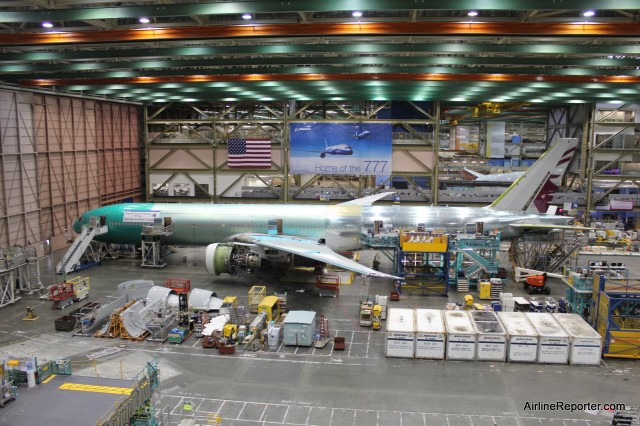
Taken in February 2011 inside the Boeing Factory, this 777-300ER is the 24th 777 for Qatar.
So how long does it take Boeing to build a 777? That was a question emailed to me by reader Ron Thomas and I realized I did not know. I posed the question to Boeing on how long it takes for a 777 to be built and out of the factory, how long it takes to be painted and then how much longer before actually being delivered to a customer. I decided to share the answers.
Of course depending on the paint job and possible issues, these numbers can change, but this is based on the average build for a 777:
From first part to out of the Boeing factory in Everett: 49 days
Time in the paint booth: 4 additional days
Flights and testing: About 30 additional days
Total from first part to delivery: About 83 days — less than three months.
That truly is beyond impressive and if you have ever taken a tour of the Boeing factory, you know that they make it look so easy.
PORTER AIRLINES REVIEW BASICS:
Airline: Porter Airlines
Aircraft: Bombardier Q400
Route: Billy Bishop Toronto City Airport (YTZ) to Montreal’“Pierre Elliott Trudeau International Airport (YUL)
Class: Economy
Seats: 13B (aisle) and 15D (window)
Length: About 70 minutes (each way)
Cheers: Everyone gets treated like they are flying first class — including free wine and beer.
Jeers: Some people might not like riding on a turbo-prop.
Overall: This is the way flying should be — and a rarity to find it on a regional carrier.
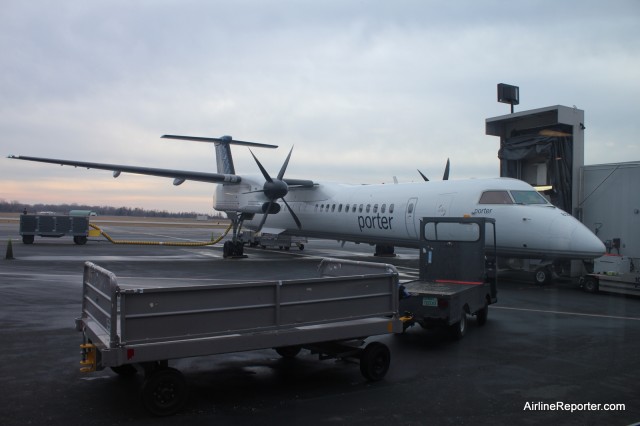
Porter Airlines Bombardier Q400 sits at Toronto.
THE FULL PORTER AIRLINES REVIEW:
During a recent trip to Toronto, I had the opportunity to fly to Montreal and back using Porter airlines (disclosure: the trip was paid for by Bombardier to check out their Cseries in Montreal). Being based in Seattle and flying Horizon/Alaska quite a bit, I am no stranger to the Q400 aircraft. There have been quite a few times that when I talk to people about the Q400, I am asked if I have tried Porter Airlines. Luckily, I can now say that I have — and that is a good thing.
When flying Porter Airlines, getting to the airport was half the fun. I walked about a mile (could have easily taken a cab, bus or subway, but it was a nice morning), hopped on a shuttle bus, then took the world’s shortest ferry ride. For those that love anything that involves transportation, the experience is pretty cool. So why a ferry? Well, that is kind of a long story.
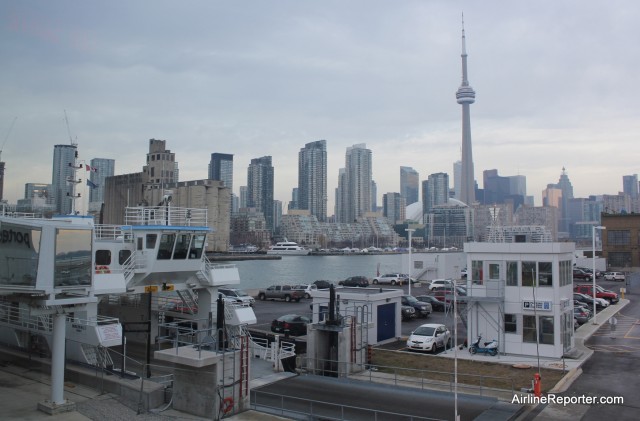
After arriving at Billy Bishop airport, be sure to turn around and catch the view of the ferry with Toronto in the background.
Billy Bishop Toronto City Airport is located on an island in Toronto and is restricted to prop aircraft and helicopters. When Porter first began looking at starting operations there, they were under the assumption that a bridge would be built to allow easy access. There was some fun political stuff that went down and no bridge has been built. Instead, the airport runs a small ferry that can hold cars and passengers from the “mainland” over to the island. Don’t blink, because you might miss the ride — it is the shortest ferry ride in the world.
The Toronto Port Authority is in the process of creating a pedestrian tunnel that will allow easier access and reduce the onslaught of passengers that come with each arriving ferry. The ferry will still operate once the tunnel is completed (which they are expecting to be done in 2014), to handle car traffic and presumably passengers who want to get the full experience.
I was staying in downtown Toronto and decided to make the one mile walk to the Royal York Hotel, where Porter Airlines operates a free shuttle to the ferry . Even with the walk, shuttle and ferry, it was less than an hour from my hotel room to my gate, which was quite impressive.
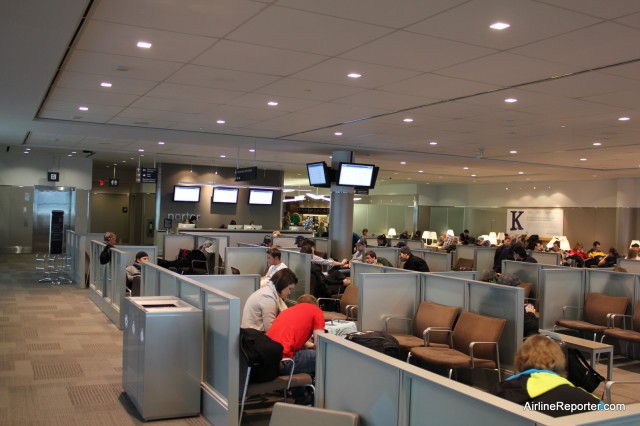
Porter Airlines waiting area is nicer than some airline first class lounges I have been in -- and everyone gets access.
Since all I had was a camera, it was quick and easy for me to get through security. Every time I go through airport security any place that is not in the US, I am reminded how much better it can be. I was greeted with a big smile and asked how I was doing (what… is this a trick?). I asked if I needed to take off my shoes and I was told no. He looked at my belt and said, “that might make the alarm go off,” and I explained it never had before and he let me through (very different from the barking orders that the TSA gives).
This is when things really get different. Instead of having a bunch of uncomfortable seats with bad lighting, the Porter Airlines waiting area is like a first class lounge — and a good one at that. I have been in a few first class lounges of other airlines that have been worse than Porter’s waiting area. There are free drinks and snacks, nothing major, but still impressive. There is free wifi and plenty of comfortable seating.This all comes at no extra charge and is just part of the Porter experience.
Before my flight I had an opportunity to sit down with Brad Cicero and Amanda Ashford, with Porter communications, to learn a bit more about the airline. They explained to me that Porter is looking to add some paid options in their lounge, including ready-to-go food and alcohol.
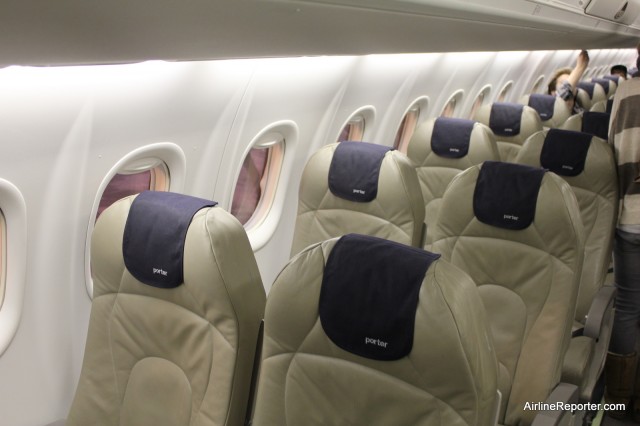
Porter Airlines offers a comfortable cabin that feels high-end, especially for a regional prop airliner.
Each flight is clearly announced and people line up at one of three doors before heading to one of ten gates. With most regional prop aircraft, you have to (well “get to” for airline fans) go on the tarmac to board. This can be okay some times of the year, but winter in Toronto has a way of getting a bit cold. So, the airline helped to design a customized boot to allow an inside hallway to connect to the aircraft, keeping passengers out of the elements.
The Q400 is not known for having spacious overhead bins (although the Q400nextgen does do a pretty good job) If you have a larger carry-on, you can give it to the Porter employee at the gate and they will return it to you once you land. This is a similar service that Alaska and Frontier Airlines also offer on their Q400s.
Porter has arranged their Q400s with a 34″ seat pitch with 70 seats vs the typical 78 seat set up. All the seats are leather and the interior uses lighter color tones. It felt more like someone’s personal aircraft than an airliner. On both my flights I had a seat mate, which didn’t give me too much room side-to-side — although I am a bit bigger of a guy. I was sitting in the aisle going to Montreal and I would really have to bring my shoulder in from being hit by people passing in the aisle.
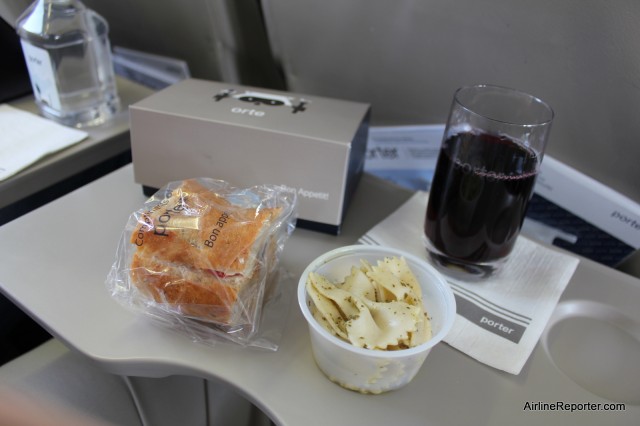
Yea, this might have been a 11:30am flight (8:30am Seattle time), but I had to test out the free wine for my story.
Just because the flight was only an hour doesn’t mean that passengers don’t get full service. A bit after take off the flight attendants started down the aisle giving out meal boxes and drinks. On the way to Montreal I had a chicken sandwich with pasta and on the way back was a chicken wrap with veggies. Now, these are not full meal portions, but way more than you would expect in economy on almost any other domestic airline. Not to mention you also get free beer or wine — in a real glass.
The flight attendants have classic uniforms that look professional and the four I was able to interact with seemed to actually enjoy their job and positively interacted with passengers, even though they had a short time line to complete their service.
The weather in Montreal was foggy and a bit snowy, so we did not see the ground until we almost touched down. Even sitting near the rear of the plane, it is always a quick de-boarding process on the Q400.
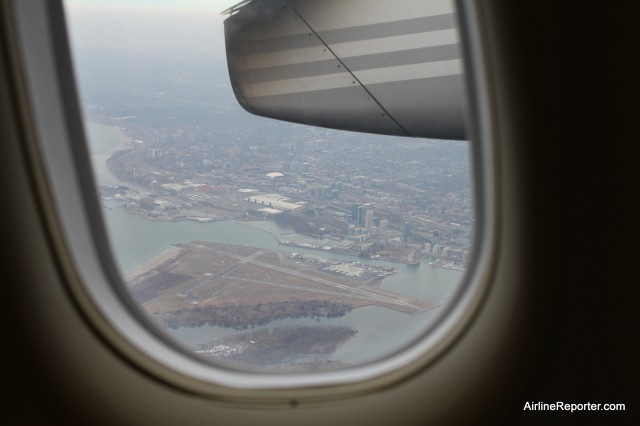
Billy Bishop Toronto City Airport (YTZ) seen from the Porter Airlines Q400.
After a few hours in Montreal, I was back at the airport ready to take another ride on Porter. The ride back was equally enjoyable. This is an airline that seems to be in at the right place at the right time, offering the right service.
They are working towards getting US Customers Pre-Clearance in Toronto, so that they can expand routes into the US that do not have customs. Porter is also planning to bring lounges to additional airports that they serve like Montreal and Newark, sometime in the future.
Previously the airline has not turned a profit and has been around 50% passenger load. Once completing the numbers for 2011, they are hoping to show a profit and occupancy loads to be around 60%, helping to fuel future growth for this unique airline.
VIEW ALL 20 PHOTOS FROM MY PORTER AIRLINES FLIGHT
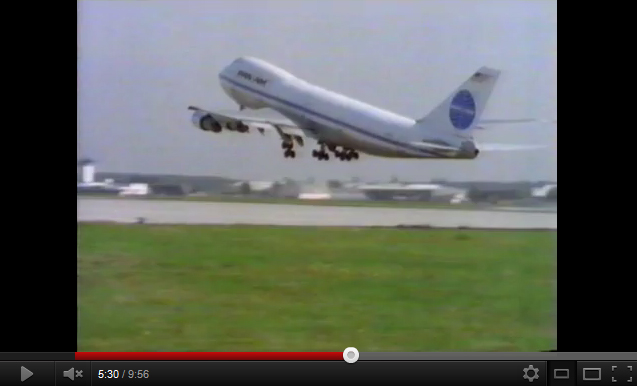
Click on the image to watch the Pan Am Boeing 747 video.
This is a pretty slick video showing the ins and out of a Pan Am Boeing 747-100. It does not start out in English, but no worries, it turns into English and what you see is much more important than what you hear anyhow.
From the control tower, to starting up the engines to the cockpit, to the Worldport — this is one sweet classic ten minute video that shows off Pan Am 747 Clippers: N656PA, N750PA and N741PA.
Enjoy!
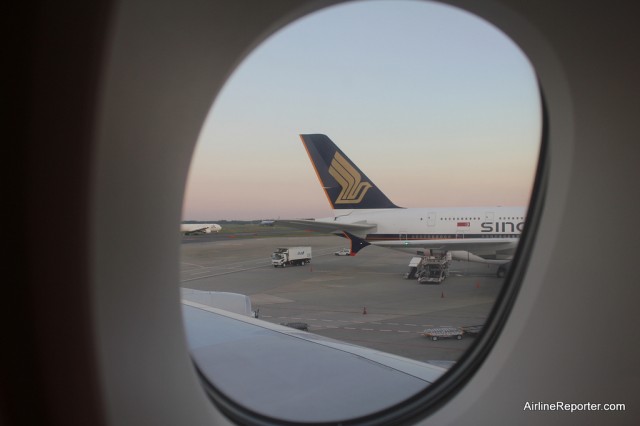
No Airbus A380 wings are going anywhere -- simmer on down folks.
“If it bleeds it leads” — a nice classic saying of writing sensational stories to get more traffic.
When I first heard of small cracks being found on Qantas and Singapore Airlines A380s I read up on it and found it to be a non-issue and not really worthy of writing a story. The majority of media covered it the way that they should — that cracks were found and they are no big deal. Some examples:
Toronto Star by Lesley Ciarula Taylor:
‘Non-critical’ cracks inside wings of Airbus A380 spark grounding call
ATWOnline by Geoffrey Thomas:
Minor cracks found in Qantas A380 wings pose no safety threat
Reuters by Harry Suhartono and Narayanan Somasundaram:
Singapore Air, Qantas say cracks found in Airbus A380 wings
USA Today by Ben Mutzabaugh:
Cracks found on A380 wing parts called ‘non-critical’
Then I start seeing more and more sensational headlines that were very misleading and it started to frustrate me. They acted like planes were going to start falling out of the sky and everyone needs to panic. Some of those examples:
Daily Mail by Rob Waugh:
World’s biggest super-jumbos must be GROUNDED, say engineers after cracks are found in the wings of three Airbus A380s
– Wow, even capitalizing the word “grounded” — classy.
CNET by Edward Moyer:
World’s largest passenger plane may be unsafe, some say
– I love the “some say,” it doesn’t really matter who, just some people are saying it and we are reporting it.
Gizmodo by Jamie Condliffe:
Airbus Refuses To Ground A380s Despite Cracks In Their Wings
– Or, they might refuse to ground them, because they do not need to be grounded.
BBC News by Tim Allman:
Airbus A380 fleet should be grounded, say engineers
– Well if engineers are saying it, then it has to be true.
What interests me is that those “some say,” and “engineers” all turn out to be the same one person in all these stories…
“We can’t continue to gamble with people’s lives and hope they make it until their four-year inspection,’ said Steve Purvinas, federal secretary for the Australian Licensed Aircraft Engineers Association.
What almost all the news sources do not say is that Purvinas’ organization has been fighting against Qantas’ decision to outsource maintenance jobs. Interesting huh? It would seem to me that this guy and the ALAEA might have an agenda.
Safeskies (an organization specializes in airline safety) chairman David Forsyth stated that, “I doubt the ALAEA union which made the comments, is technically trained or qualified to argue against Airbus structural design engineers about cracks in their aircraft. Airbus will investigate these cracks and promulgate an inspection program, agreed by the safety Regulators.” He continued with, “Using safety as a weapon in IR disputes, without reasonable grounds, is like the boy who cried wolf. Repeated ad nauseam, the impact will lessen over time, and if eventually there is a valid safety issue, it might be dismissed as just another rant.”
Airbus has confirmed the cracks, but stated that they are not a safety issue. “We have traced the origin to a material-related manufacturing issue and developed an inspection and repair procedure which will be done during routine, scheduled, maintenance checks. This is not a safety issue. Aircraft performance is not affected. Any fix, if necessary, can be done during regular (4 year) maintenance.”
Every single airliner ever build has had issues that do not affect safety. Aircraft manufactures issue thousands of service bulletins and the huge majority of them are very minor.
This really is a non-story that should have never received much coverage outside airline trade journals. Yet, it was too tempting for some journalists and their editors to write that an engineer stated that the fleet of A380s should be grounded. The airline business is a disproportionately mis-represented business already and stories like this do not help the situation.
 I wish I had some additional news to share about Aviation Geekfest 2012, but right now the Future of Flight and I are still working things out and since nothing has been 100% locked down, I am unable to share the details. I can say that #AGF12 should be bigger and better than any one before it and I am very excited.
I wish I had some additional news to share about Aviation Geekfest 2012, but right now the Future of Flight and I are still working things out and since nothing has been 100% locked down, I am unable to share the details. I can say that #AGF12 should be bigger and better than any one before it and I am very excited.
It looks like it will probably start either late morning or early afternoon and go into the evening on Sunday February 19th. There were will be parts where you must sign up (because of limited space) , but others when anyone and everyone can show up (later in the event).
We aren’t sure what will happen right now, but I can tell you that something WILL be happening — so make plans to be here.
What you can do for now is sign up for the #AGF12 mailing list. By signing up, you will make sure to hear about all the updates as soon as we have them. Although I will keep updating my blog about details, it is best to be on the list since there were will be limited slots for the really cool stuff and you do not want to be late to register.









